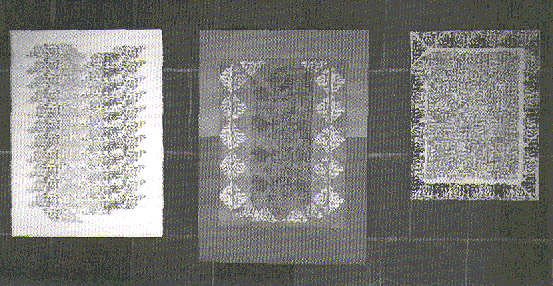
February 1999
Partnerships at Dartmouth: Mathematics, Art, and the Humanities
Last summer, near the end of the Appalachian Trail, a bearded New
Englander, challenging certain immutable laws of gravity and motion,
juggled clubs and balls on the great green mall of Dartmouth College.
Rick Zang, a mathematician from the University of New Hampshire,
Manchester, was one of 42 participants at the first NSF-funded "MAA
Partnerships Workshop on Art, Humanities, and Mathematics."
The MAA Partnerships project is a series of four summer workshops
linking mathematics with partner disciplines. Teams of faculty
representing the disciplines of the workshops build multidisciplinary
teams while working on materials developed by the projects funded by NSF
in the "Mathematical Sciences and Their Applications Throughout the
Curriculum" (MATC) program. The goal of the project is to have faculty
build partnerships in their home institutions while developing their own
interdisciplinary materials or adapting the materials developed by the
MATC projects for use in their own courses. The Summer 1998 workshop
focused on connections between mathematics and art and the humanities.
As July came to an end, over three dozen faculty journeyed from around
the country to Dartmouth to discuss Borges and Newton; swirl colorful
fractals; block-print geometrical variations; plot perspectives of
cathedral naves; revisit Fermat's last theorem and Zeno's Paradox (some
of us were Achilles, some the tortoise); and nervously, then gallantly,
studio-act Tom Stoppard's Arcadia, all the while making mathematical
connections.
Mathematicians and literary critics, artists and writers, philosophers,
historians, and engineers had agreed to wrestle with the cliche of
"interdisciplinary studies" to earth, or learn to fly with it. Guided
and inspired by expert teaching faculty, participants were quick to see
the dangers of superficial chatting, mere dilettantism. The very real
differences among disciplines called for thoughtful reconsideration by
our practicing together the "messy" art, performing the play, searching
the philosophy, doing the math.
Jeremy Case (Taylor University) "appreciated seeing that other
disciplines have to go through problem-solving steps, albeit with a
slightly different approach." From a Partnership perspective, he
"appreciated the interaction of art and mathematics, especially. Often I
hear people say that 'I cannot do math.' I discovered that people also
say, 'I cannot do art.'"
Rick Zang was approached by a student who indicated that he was doing a
documentary on juggling for his journalism project that summer. There on
the Dartmouth green, Rick demonstrated various juggling patterns and
explained about all the mathematics to be found in juggling, plus all
the neat metaphors about learning to be found through/ in juggling.
(Subsequent to the interview, the student produced a very nice videotape
and sent it to the math department at Dartmouth. This is an example of
mathematics across the curriculum and exemplifies the interdisciplinary
nature -- journalism, performing arts, and mathematics -- of what we
were trying to achieve at Dartmouth.)
Mathematics & Writing
As the days passed, participants grew aware not only of the depth of
others' disciplines but also of their own. In intensive work sessions,
we looked closely at how mathematics may be taught through writing, and
vice versa. Working to demonstrate our different ways of inquiry, we
re-encounted experiences that too often grow stale in the classroom: we
respectfully taught and greedily learned from one another. We read
Kepler and relocated our perspectives to another planet looking back at
our own. We pored over Hilbert and Berkeley to reassess our comfortable
daily assumptions about limits. We entered the intricate world of Borges
and recalled Shylock, Sherlock Holmes, and Cantor. We examined the
geometry of cathedrals and re-evaluated terms such as order, symmetry,
and beauty. We measured facades with make-shift theodolytes. We watched
for symbols at every turn, in language, in visual art, in statistics, in
the description of motion in calculus.
Number Systems
Exploring various number systems, we learned African concepts of space
and time, entered ethnomathematics to observe how anthropologists think
about math in its contexts of the human body and cultural practice. Of
the many debates that ensued one that recurred was the perspective of
infinity and infinitesimals. Mathematicians and non-mathematicians alike
struggled with the concepts of infinite sum, instantaneous velocity,
countable and uncountable sets from both a mathematical and a
philosophical perspective. Some who thought they had settled these
concepts long ago were confronted again with thorny issues at the very
foundations of mathematics. Some were consoled and others distressed by
the claim that if the mathematical solutions do not perplex you, you are
missing the point.
Volume 19, Number 2
Tina H. Straley and Robert W Hill


![]()